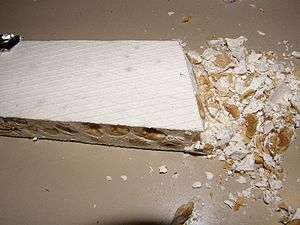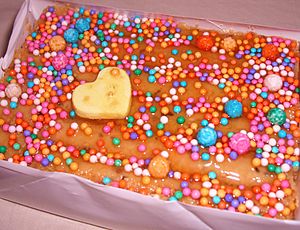Turrón facts for kids
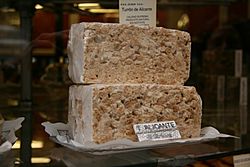
Turrón from Alicante
|
|
| Alternative names | Torró, torrone, torrão, turon, turrone, nougat |
|---|---|
| Type | Confectionery |
| Main ingredients | Honey, sugar, egg whites, almonds or other nuts |
Turrón is a super sweet candy, a bit like nougat. It comes from places in southwestern Europe. This yummy treat is usually made from honey, sugar, and egg whites. It also has lots of toasted almonds or other nuts. Turrón is often shaped like a rectangle or a round cake. People love to eat it as a special Christmas dessert. You'll find it in Spain, Portugal, and Italy. It's also popular in countries that were once part of the Spanish or Portuguese empires, especially in Latin America.
Contents
What's in a Name?
This sweet nougat candy has similar names in different languages. In Spanish, it's called turrón. In Catalan, it's torró. The Italian name is torrone. In Portuguese, you might hear torrão or torrone. In the Philippines, it's known as turon.
How to Make Turrón
The oldest Spanish recipe for turrón might be from a 16th-century book. It's called Manual de Mujeres, which means "Women's Handbook." This recipe tells you to cook honey and some egg whites. You cook them until they become hard when cool. After the honey turns golden, you add toasted nuts. These could be pine nuts, almonds, or hazelnuts. The mix is cooked a little more. Then, it's taken off the heat and cut into slices.
A Sweet History
The name turrón likely comes from the Latin word torrere. This word means "to toast." The modern candy might have come from an old Muslim recipe. This recipe was popular in parts of Islamic Spain and was called turun. There was also a similar candy in Ancient Rome. It was called cupedia or cupeto.
Turrón has been around since at least the 1400s. It was known in the city of Jijona/Xixona in Spain. Today, turrón is eaten across most of Spain. It's also popular in some Latin American countries and in Roussillon, France. A similar candy, Torrone, is famous in Cremona and Benevento in Italy. You can also find similar sweets in the Philippines.
Different Kinds of Turrón
Turrón can be hard and crunchy, or soft and chewy. For a long time, most turrón recipes were the same. But now, there are many different kinds! You can find chocolate turrón with puffed rice or whole almonds. There are also chocolate candies with or without alcohol. Some have candied fruits or whole nuts. There are even sugar-free versions.
Spanish Turrón
Traditional Spanish turrón usually comes in two main types:
- Hard Turrón (Turrón Duro): This is also called the Alicant variety. It's a solid block of whole almonds. These almonds are mixed with eggs, honey, and sugar. About 60% of it is almonds. It can be very hard to break!
- Soft Turrón (Turrón Blando): This is known as the Jijona variety. Here, the almonds are ground into a paste. A little oil is added to make it stick together better. About 64% of it is almonds. Soft turrón is much more crumbly and chewy.
Other types include Torró d'Agramunt and Torró de Xerta. Today, the word turrón in Spain means many other sweet bars. These bars are usually about 20 x 10 x 3 cm. They can have chocolate, marzipan, coconut, caramel, or candied fruit.
Italian Torrone
Torrone is a traditional winter and Christmas candy in Italy. There are many kinds, but they use fewer nuts than Spanish turrón. Traditional torrone from Cremona can be soft and chewy (morbido) or hard and brittle (duro). They might have citrus flavors or vanilla. They can also contain whole hazelnuts, almonds, and pistachios. Some are even dipped in chocolate.
Torrone di Benevento from Benevento is sometimes called Cupedia. This name is very old. The crumbly version is made with hazelnuts. The softer version uses almonds. This Torrone di Benevento is thought to be one of the oldest types.
Peruvian Turrón
In Peruvian cuisine, turrón is usually soft and tastes like anise. The original Spanish recipe was changed in Peru. This was because some ingredients were hard to find or expensive. A popular kind in Lima is Turrón de Doña Pepa. It's an anise and honey nougat. People traditionally make it for a religious parade in October.
Philippine Turrón
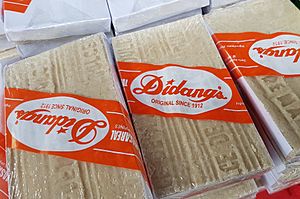
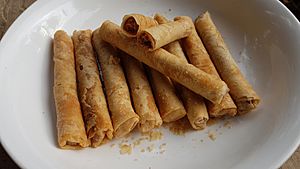
A type of turrón from Pampanga Province is made with cashew nuts. It's called turrones de casúy. It's a bar of marzipan wrapped in a white wafer. Unlike in other Spanish-speaking places, this candy is not for Christmas. Another kind is turrones de pili, made with the local pili nut.
A similar sweet is masareal from Mandaue. It's made from ground boiled peanuts, sugar, and water. It's usually not as dry as turrón.
A very different street food is the turón. This is a dessert version of the Filipino lumpia (spring roll). The most common is turón na saging. This has sliced banana or plantain dipped in brown sugar. It's wrapped in a spring roll wrapper and deep-fried. There are also other turón fillings. These include ube (purple yam), sweet potato, and even peanuts.
Puerto Rican Turrón
In Puerto Rico, turrón is called Turrón de Ajónjolí. This means "sesame turrón." It's made with toasted black and white sesame seeds. It also has ground cinnamon and lemon juice. These are all held together by caramelized brown sugar and honey. Other types can have almonds, lime zest, sunflower seeds, or toasted coconut flakes.
Cuban Turrón
In Cuba, turrón de maní (peanut nougat) is a favorite sweet. Small bars are often sold at bus stops. You can also find larger loaves for families. There are two types:
- Soft (blando): Ground peanuts are pressed into bars with brown sugar.
- Hard (duro): Coarsely chopped roasted peanuts are held together with caramelized sugar and honey.
Special Status
Some types of Turrón/Torrone have a special protected status. This means they can only be made in certain places. These include:
- Jijona (PGI) from the Valencian Community
- Turrón de Alicante (PGI) from the Valencian Community
- Torró d'Agramunt (PGI) from Catalonia
Other types, like Torrone di Cremona in Italy, also have protected status in their own countries.
See also
 In Spanish: Turrón para niños
In Spanish: Turrón para niños


